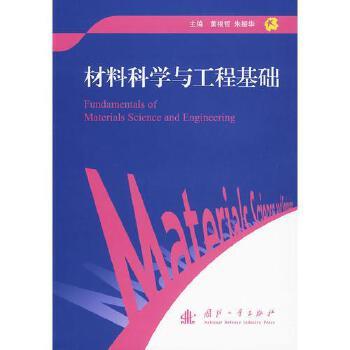《材料科學與工程基礎:英文》是2010年1月國防工業出版社出版的圖書,作者是黃根哲、朱振華。
基本介紹
- 中文名:材料科學與工程基礎:英文
- 作者:黃根哲、朱振華
- ISBN:9787118063493
- 類別:教材
- 頁數:199
- 定價:25
- 出版社:國防工業出版社
- 出版時間:2010年1月
- 裝幀:平裝
- 開本:16

《材料科學與工程基礎:英文》是2010年1月國防工業出版社出版的圖書,作者是黃根哲、朱振華。
《材料科學與工程基礎:英文》是2010年1月國防工業出版社出版的圖書,作者是黃根哲、朱振華。內容簡介本書共分7章,分別闡述了晶體結構與晶體缺陷、金屬機械性能、二元合金相圖、鐵碳合金相圖、鋼的熱處理、碳鋼及合金鋼、有色金屬...
《材料科學與工程基礎》是2005年清華大學出版社出版的圖書,作者是(美國)阿斯克蘭德。內容簡介 本書是《The Science and Engineering of Materials》第4版的節選本。原書曾是美國工學院裡所開設的“材料科學與工程”課程所用的教科書中...
材料科學與工程專業畢業的學生,既可從事材料科學與工程基礎理論研究,新材料、新工藝和新技術研發,生產技術開發和過程控制,材料套用等材料科學與工程領域的科技工作,也可承擔相關專業領域的教學、科技管理和經營工作。培養規格 學制與學位...
《材料科學與工程基礎:第5版》是2004年1月化學工業出版社出版的圖書,作者是凱里斯特。這本書是國外名校的原版材料科學體系教材。中文名 材料科學與工程基礎:第5版 作者 (美)凱里斯特 出版社 化學工業出版社 出版時間 2004年1月...
《材料科學與工程基礎(英文版·原書第5版)》是2011年機械工業出版社出版的圖書,作者是smith。內容簡介 主要內容有:材料科學與工程引論、原子結構與鍵合、材料中的晶體結構和非晶態結構凝固和晶體缺陷、熱激活過程和固體中的擴散、金屬...
政治理論課、外語課、工程數學、材料物理化學工程、材料工程理論基礎、材料結構與性能、材料結構和性能檢測技術、材料合成與製備技術過程控制原理、計算機技術套用、近代材料的研究方法、材料科學與工程的新進展以及現代管理學基礎等。
材料科學與工程專業英語(第4版) 編寫本教材的目的是為了讓本科生在經歷了大學一、二年級的基礎英語學習後,通過閱讀本書,實現英語教學的不斷線,使英語水平再上一個新台階。在第一、二、三版的基礎上補充了材料科學與工程的總體介紹,...
《材料科學與工程基礎》是2016年化學工業出版社出版圖書,作者是美國的小威廉·卡麗斯特(William D.Callister,Jr.)和大衛·來斯威什(David G.Rethwisch)。內容簡介 本書是《材料科學與工程基礎》的第四版,相比前三版,本版補充修改...
內容設定反映了材料研究的基本理論,適合材料科學與工程一級學科寬口徑的專業培養。該書由六部分構成,第一部分概述材料科學與工程學科發展,第二部分講述材料科學的物理冶金基礎內容,第三部分講述材料的物理性能,如電、熱、磁及光性能,...
材料科學與工程:中英文A版 《材料科學與工程:中英文A版》是由美國大衛出版公司主辦的期刊。該期刊館藏於國家圖書館、上海圖書館
《材料科學和材料工程》是2003年出版的圖書,作者是D.W.Pashley。內容簡介 《材料科學和材料工程(英文版)》內容簡介:Newly appointed or newly promoted professors at Imperial College are required to give an inaugural lecture on a...
材料科學與工程:中英文B版 《材料科學與工程:中英文B版》是由美國大衛出版公司主辦的期刊。該期刊館藏於國家圖書館、上海圖書館
《材料科學與工程基礎(第2版)/材料科學與工程系列》為普通高等教育“十一五”和“十二五”國家規劃教材。《材料科學與工程基礎(第2版)/材料科學與工程系列》應高等院校“材料科學與工程”學科改革而生,將材料科學和材料加工的基礎...
《材料科學與工程基礎》是2009年機械工業出版社出版的圖書,作者是楊慶祥。內容簡介 本書為普通高等教育“十一五”國家級規劃教材。為適應高等教育體系設定寬口徑專業的改革要求,本著加強基礎、淡化專業的宗旨和各校授課時數普遍減少的實際...
《材料科學與工程基礎》是2010年上海交通大學出版社出版的圖書。內容簡介 《普通高等教育“十一五”國家規劃教材·材料科學與工程學科教材系列:材料科學與工程基礎》為普通高等教育“十一五”國家規劃教材。《材料科學與工程基礎》應高等院校...
《材料工程技術專業英語》共分為5個教學單元,每個單元由多篇課文和一篇課外閱讀組成,分別介紹水泥、玻璃、混凝土、玻璃鋼、建築材料等的材料性能、組成、生產工藝等,重點介紹材料的生產工藝和設備。每篇課文後都附有形式多樣的練習題,...
《材料科學與工程基礎(上冊)》是2015年12月高等教育出版社出版的圖書,作者是劉國權。內容簡介 《材料科學與工程基礎(上冊)》遵循材料類和機械類專業厚基礎、重套用、寬口徑的特點與要求,既側重材料科學基礎與材料工程基礎內容,同時又...
《材料科學與工程基礎(第三版)》是2020年2月化學工業出版社出版的圖書,作者是趙長生。內容簡介 本書共分5章:緒論、材料結構基礎、材料組成與結構、材料的性能、材料的製備與成型加工。從材料科學與工程的基本原理出發,綜合介紹了各種...
《材料工程基礎》是2004年清華大學出版社出版的圖書,作者是王昆林。本書闡述了材料科學與工程的基礎理論及其在材料加工工程中的套用,介紹了材料的成分、加工工藝、組織結構和性能之間的關係。內容簡介 本書為北京市高等教育精品教材。 本...
為加深理解和學用結合,每部分都附有思考題和習題,使學生能夠掌握本專業最基本的英文辭彙,為將來的學習及研究工作打下良好的基礎。《材料工程專業英語》可作為高等職業技術教育和高等專科學校的材料成型、冶金及相關專業的專業英語教材,...
《功能材料學基礎(英文版)》可作為一級學科(例如,材料科學專業、材料科學與工程專業)、二級學科的工科材料類(例如,無機非金屬材料工程、複合材料與工程等專業)和理科材料類(例如,材料物理、材料化學、新能源等專業)本科生課程“...
基礎課程 大學英語,高等數學、線性代數、機率論和數理統計,建築力學,結構力學,土木工程製圖,CAD等。主要課程 理論力學、材料力學、結構力學、流體力學、土力學、建築材料、混凝土結構與鋼結構、房屋結構、橋樑結構、地下結構、道路勘測...
